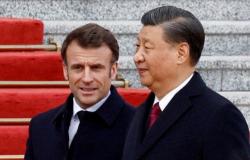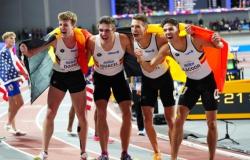The CVC investment group appears on the Euronext Amsterdam price tables for the first time on Friday. The road to the fair was paved with obstacles, but the third attempt turned out to be the right one. A look under the hood of the private equity giant.
What do the sauces from Devos & Lemmens, Bpost, the lighting chain Massive and the specialist in shoe and watch repairs Mister Minit have in common? You may not know it, but all those Belgian companies were sooner or later owned by CVC.
CVC? Ask the man in the street for the three-letter word and chances are he will guess it. Yet the discreet Anglo-Saxon financial giant is one of the world’s biggest players in its industry: debt-financed takeovers (leveraged buyouts or LBOs in the jargon). CVC buys companies, guides their growth path – cashing in when possible through dividends or other capital distributions – and then sells them on or takes them to the stock exchange.
The essence
- CVC will list on the Amsterdam stock exchange on Friday. From then on, private individuals can also trade in shares of the financial giant.
- What started in the 1990s as a spin-off from Citicorp grew into a financial giant with 186 billion euros in assets under management.
- The documentation bundle of the IPO provides a detailed look at CVC’s figures for the first time.
- In Belgium, CVC is a shareholder in, among others, the HR service provider SD Worx and the gaming group Gaming1. In the past, CVC was also on board with Bpost, the lighting specialist Massive or the company behind the Devos & Lemmens sauces.
Now CVC itself is taking the step to the stock exchange. Or rather: it finally takes that step, because two previous attempts failed. First, the Russian invasion of Ukraine in early 2022 threw a spanner in the works. Afterwards, the Hamas attack and the Israeli war in Gaza disrupted the plans in the autumn of last year.
When Iran fired missiles at Israel two weeks ago in retaliation for an Israeli airstrike on the Iranian consulate in the Syrian capital Damascus, it seemed like that again. But when it became apparent that the financial markets were not taking into account an escalation of the conflict in the Middle East, the CVC executive committee pushed the button, according to a reconstruction by the British business newspaper Financial Times.
Not everyone at the top of CVC was keen on an IPO and the transparency that comes with it, but the group was moving in the same direction. There would never be a perfect time to go public, was the reasoning of the 18 members of the executive committee. One of them is the West Flemish Geert Duyck.
Double exit
Those who will no longer experience the IPO from the front row are Donald Mackenzie and Steve Koltes, two co-founders of CVC. Their recent departure from the company must be seen in light of the stock exchange plans. Pour live heureux, live your lives. They may be out of the picture at CVC, but they are still shareholders of the group and will earn a lot from the IPO. The operation’s 513-page documentation bundle (prospectus in jargon) shows that they will sell 10 million and 2.5 million shares respectively. That will earn Mackenzie up to 150 million euros and Koltes up to 45 million.
MacKenzie and Koltes, who still retain a strong package of shares, are old hands in the business. They co-founded CVC in the 1990s when a series of European executives from Citicorp Venture Capital split from the bank of the same name to establish the private equity group. Three decades later, CVC is a financial giant that last year launched a 26 billion euro fund, the largest takeover fund ever. That money came, as always with private equity, from pension funds, insurers, asset managers and wealthy individuals.
The CVC group had 186 billion euros in assets under management at the end of last year. Private equity – investing in unlisted companies – accounted for the largest share (116 billion) of this. This CVC branch is a shareholder in the British top division of rugby and the Six Nations rugby tournament, the tea brand Lipton, the perfume chain Douglas and the Spanish football competition La Liga. In addition, CVC also has vehicles with a focus on infrastructure and acts as a lender in acquisitions.
The investors in the CVC funds also include Belgians. And the financial giant also has several Belgian advisors: the former liberal minister Karel De Gucht, Duco Sickinghe (ex-CEO of Telenet) and Johnny Thijs (ex-CEO of Bpost).
Cash machine
The prospectus of the IPO provides detailed insight for the first time into what kind of cash machine CVC is. Last year, the private equity giant recorded revenues of 1.33 billion euros. After deducting a range of costs – including commissions for advisors (400.4 million euros), personnel and administrative costs – gross operating profit (EBITDA) amounted to 693.5 million euros.
More than half of revenues (744.6 million euros) came from fund management fees. In addition, CVC’s teams earned 394 million euros on the added value they realized on divestments, a quarter more than the previous year. Sharing in those added values is known in professional jargon as: carried interest.
How does a buyout work?
When a buyout fund like CVC makes an acquisition, it puts part of the acquisition amount on the table itself and borrows the other part. That debt is transferred to the acquired company, whose cash flow serves to repay the debt.
If the investor takes the ride, that financing structure can create leverage on the investment. Both the fund’s investors and the investment team share in the added value.
But it can also turn out badly: if a company does not generate enough cash flow to repay its debts, it has to sit down with its creditors. Then the banks come on board as shareholders.
CVC explains how this works in its prospectus. Suppose a fund realizes a capital gain of 138 million euros on an investment. The majority of this (80% or 110 million) flows back to the fund’s shareholders – often pension funds, insurers, asset managers, sovereign wealth funds or (very) wealthy private individuals. The remaining 20 percent – 28 million euros – flows to CVC, its employees, ‘strategic’ partners and any former employees. CVC will receive 9 million euros (30%) of this, the investment team involved and the other involved parties 19 million euros (70%).
According to the IPO prospectus, CVC’s seven acquisition funds achieved an annual return (Internal Rate of Return or IRR) of 28 percent. According to CVC, investors received an average of 2.9 times their investment back.
Amsterdam
Following the IPO, the same investors could also invest in the listed CVC. The financial giant sold between 16.6 million and 19.1 million new shares and 96.2 million existing shares as part of its IPO in Amsterdam. The price range was set at 13 to 15 euros per share. The sale of new shares should generate around 250 million euros. The selling shareholders are mainly the sovereign wealth funds of Singapore and Kuwait, an asset manager from Hong Kong and some former partners of the financial giant.
The parties that do not sell shares include the Dutchman Rolly van Rappard, one of the co-founders of CVC. He is not selling shares because he remains active at the company, he told Het Financieele Dagblad.
Van Rappard owns almost 7 percent of CVC. He will become chairman of the board of directors. Given that CVC’s top vehicle is based in Jersey, the board of directors will continue to meet on the Channel Island, the prospectus shows. The company is not keen on a move for tax reasons.
Belgian connection
Van Rappard also has ties with Belgium. His family invested in their own name in Vision Healthcare, the digital platform for nutritional supplements and vitamins from entrepreneur Yvan Vindevogel. CVC and Vindevogel know each other well: together they are shareholders in the French specialist in over-the-counter medicines Cooper, which bought the European branch of the American Viatris six months ago in a billion-dollar deal.
Belgian CVC partners Steven Buyse and Michael Lavrysen are also on board at Vision Healthcare. Buyse is one of the 41 managing partners of CVC, Lavrysen one of the 110 partners. Buyse and Lavrysen often invest in their own names. Both, together with Geert Duyck, are on board at RSC Anderlecht. Buyse also invested in the Kortrijk Spurs basketball team and the Get Driven driver service. In the latter two he is a co-shareholder alongside Steve Rousseau, who recently sold his HR company World of Talents to CVC.
Duyck, together with Buyse, set up the Belgian CVC office in 1998. They put the financial giant on the map in the Benelux and France with deals involving the Blagden barrel group, Bpost or Massive.
Duyck has been investing time and resources in and around Brussels, his new home, for some time. He supported the Toekomstatelier (Tada), a project that supports underprivileged teenagers in Brussels. He is also a silent partner and co-shareholder of the gueuze maker 3 Fonteinen. Buyse, for his part, supports Entrepreneurs Without Borders, which wants to reforest the Sahel.





